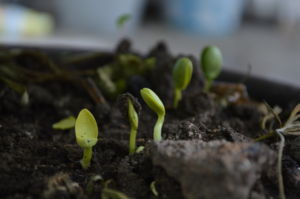Residual flows of green waste, we all have to deal with it in both direct and indirect form. Green waste from our household goes straight into the green container or on our own compost heap. But there is also an indirect green flow that we observe, but do not think about. That is the green from outside our gardens and grounds. The residual material leaves and grass from the municipal green areas. Think of the verges in the street, the village or along the highway. Or for example the leaves and weeds from the municipal flower beds.
We all often see this type of biomass and when it is not done for too long we all have an opinion about it… How is this actually processed? AND what does that have to do with Rinagro ?!
It is currently a hot topic to process and re-use such green residual flows as much as possible within their own municipalities, and preferably at the same location where they are extracted . A number of pilots have also been set up for this by municipalities themselves and green processors in the region.
One of these initiatives is the processing of this verge cuttings in bales and on heaps/ensiled via the commercial composter. Since these companies also want to move with the times, they also see challenges in a number of known side effects, namely low pH value, emissions, leaching and especially the principle that part of the organic material was not converted/affected during the processing time together with the necessary germination power in the weed seeds.
By chance, they had come across Mr. R Joustra himself and got talking about the differences in the operating principles. Curious as they were, they wanted to check for themselves whether what Rinagro was claiming was actually true. And so it happened. Compost-O® was purchased and set up in a parallel test.
After the period in which the heaps were given time to process , they were opened and compared. What they immediately noticed was that the heap treated with Compost-O® had shrunk considerably in size. In addition, they were surprised at the result of how far the material had already been pre-digested . This usually never happened without conversion in the existing process.
All in all, the surprise was great about the final result already achieved, but the research still had to show whether it was really of such quality as was assumed. For example, samples were taken and tests were set up to test the germination capacity of weed seeds and to index how many parasitic nematodes were present in the composted product compared to the current process.
After some time the reports came back and lo and behold, germination power of weeds 0 and even the nematodes parasitic for the plant were 0. On the other hand the good nematodes were present in large numbers.
A nice confirmation of how with treated compost the weed pressure, the disease pressure and therefore a reduction of pesticides, can be reduced!

